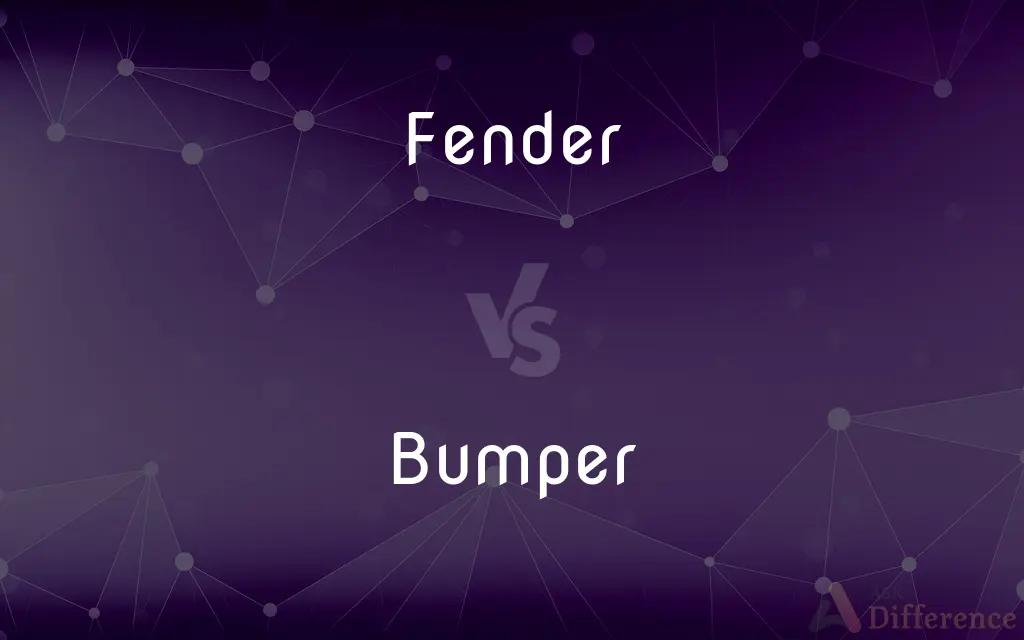Fender vs. Bumper — What's the Difference?
By Urooj Arif & Fiza Rafique — Updated on April 25, 2024
Fender protects a vehicle's wheels and body from mud and debris, focusing on the side areas; a bumper shields the front and rear from low-speed impacts.

Difference Between Fender and Bumper
Table of Contents
ADVERTISEMENT
Key Differences
A fender is primarily designed to cover the wheel wells of a vehicle, helping to prevent mud, rocks, and road debris from being thrown into the air by the spinning tires. Whereas, a bumper is installed at the front and rear of a vehicle and is meant to absorb and mitigate damage during low-speed collisions.
In terms of construction, fenders are typically part of a vehicle's body, made from materials like steel, aluminum, or plastic, and are often designed to be aesthetically pleasing as well as functional. On the other hand, bumpers are built with the specific intent of impact absorption and are usually made from more robust materials such as reinforced steel, aluminum, rubber, or plastic composites.
While fenders are an integral part of the vehicle’s body, contributing significantly to the vehicle's overall design and aerodynamics, bumpers are considered safety features designed to protect the vehicle's structure and its occupants in case of a collision.
Maintenance and repair considerations also differ; fenders, being susceptible to dents and scratches from debris or minor accidents, often require cosmetic repairs. Bumpers, however, are designed to be more durable but might need replacement or repair after collisions to ensure they provide the intended safety in future impacts.
Regulatory perspectives also impact these components differently. Fenders are regulated more on the basis of road safety concerning debris and mud control, ensuring clear visibility for other drivers. Bumpers are subject to safety regulations that ensure they perform adequately in crash tests, aimed at reducing injury to pedestrians and damage during accidents.
ADVERTISEMENT
Comparison Chart
Purpose
Protects against road debris and enhances design
Absorbs impact in collisions
Location
Over the wheels, part of the vehicle's body
Front and rear ends of the vehicle
Material
Steel, aluminum, plastic
Steel, aluminum, rubber, plastic composite
Maintenance
Often requires cosmetic repair
May need replacement after significant impact
Regulation
Debris and mud control, vehicle design
Crash safety, pedestrian safety
Compare with Definitions
Fender
A part of the vehicle’s body that frames a wheel well.
After the accident, the car's left fender was completely dented.
Bumper
A protective device at the front or rear of a vehicle.
The bumper absorbed most of the impact during the crash.
Fender
Designed to block mud, water, and debris from hitting the vehicle.
The new fender includes a splash guard feature.
Bumper
Built to mitigate damage in low-speed collisions.
The car's bumper needs replacement after the rear-end collision.
Fender
Requires regular maintenance for dents and scratches.
The mechanic suggested a paint job for the scratched fender.
Bumper
Subject to specific safety regulations and standards.
The vehicle passed all bumper safety tests.
Fender
Plays a role in vehicle aerodynamics.
Racing cars have fenders that help reduce air drag.
Bumper
Often replaceable and repairable as a separate unit.
Replacing the damaged bumper took just a few hours.
Fender
Often integrates with the vehicle’s aesthetic design.
The sports model features uniquely designed fenders.
Bumper
Made from materials like plastic, steel, or aluminum.
The new model uses a high-grade steel bumper for added safety.
Fender
A guard over each wheel of a motor vehicle, for example, that is shaped and positioned so as to block the splashing of water or mud.
Bumper
A usually metal or rubber bar attached to either end of a motor vehicle, such as a truck or car, to absorb impact in a collision.
Fender
A device at the front end of a locomotive or streetcar designed to push aside obstructions.
Bumper
A protective device for absorbing shocks or impeding contact.
Fender
A cushioning device, such as a bundle of rope or a piece of timber, used on the side of a vessel or dock to absorb impact or friction.
Bumper
A drinking vessel filled to the brim.
Fender
A screen or metal framework placed in front of a fireplace to keep hot coals and debris from falling out.
Bumper
Something extraordinarily large.
Fender
(US) panel of a car which encloses the wheel area, especially the front wheels.
Bumper
Extraordinarily abundant or full
A bumper crop of corn.
Fender
(US) a shield, usually of plastic or metal, on a bicycle that protects the rider from mud or water
Bumper
Someone or something that bumps.
Fender
(nautical) any shaped cushion-like object normally made from polymers, rubber or wood that is placed along the sides of a boat to prevent damage when moored alongside another vessel or jetty, or when using a lock, etc. Modern variations are cylindrical although older wooden version and rubbing strips can still be found; old tyres are used as a cheap substitute
Bumper
(obsolete) A drinking vessel filled to the brim.
Fender
A low metal framework in front of a fireplace, intended to catch hot coals, soot, and ash
Bumper
Anything large or successful.
Fender
(nautical) To use fenders to protect the side of a boat
Bumper
(automotive) Parts at the front and back of a vehicle which are meant to absorb the impact of a collision; fender.
Fender
One who or that which defends or protects by warding off harm
Bumper
Any mechanical device used to absorb an impact, soften a collision, or protect against impact.
Fender
A barrier that surrounds the wheels of a vehicle to block splashing water or mud;
In England they call a fender a wing
Bumper
(cricket) A bouncer.
Fender
An inclined metal frame at the front of a locomotive to clear the track
Bumper
(billiards) A side wall of a pool table.
Fender
A low metal guard to confine falling coals to a hearth
Bumper
A cylindrical object used (as a substitute for birds) to train dogs to retrieve.
Fender
A cushion-like device that reduces shock due to contact
Bumper
(broadcasting) A short ditty or jingle used to separate a show from the advertisements.
Bumper
A covered house at a theatre, etc., in honour of some favourite performer.
Bumper
A woman's posterior, particularly one that is considered full and desirable.
Bumper
(music) An extra musician (not notated in the score) who assists the principal French horn by playing less-exposed passages, so that the principal can save their 'lip' for difficult solos. Also applied to other sections of the orchestra.
Bumper
(pinball) An object on a playfield that applies force to the pinball when hit, often giving a minor increase in score.
Bumper
A cigarette butt.
Bumper
(horse racing) In National Hunt racing, a flat race for horses that have not yet competed either in flat racing or over obstacles.
Bumper
(colloquial) Large; (as if) filled to the bumpers at the top of a silo.
We harvested a bumper crop of arugula and parsnips this year.
A bumper collection of silly jokes
Bumper
To drink from the vessels called bumpers.
Bumper
A cup or glass filled to the brim, or till the liquor runs over, particularly in drinking a health or toast.
He frothed his bumpers to the brim.
Bumper
A covered house at a theater, etc., in honor of some favorite performer.
Bumper
That which bumps or causes a bump.
Bumper
Anything which resists or deadens a bump or shock, such as a metal or rubber rim extending from an object; a buffer.
Bumper
A protective guard device, usually of metal or rubber, attached horizontally to the front or rear of the frame of a vehicle, designed to resist or deaden a bump or shock, and to prevent damage to the main frame of the vehicle in low-velocity collisions.
Bumper
A glass filled to the brim (especially as a toast);
We quaffed a bumper of ale
Bumper
A mechanical device consisting of bars at either end of a vehicle to absorb shock and prevent serious damage
Bumper
Extraordinarily abundant;
A bumper crop
Common Curiosities
What is the primary purpose of a fender?
To protect the vehicle from road debris and enhance its aesthetic design.
Can bumpers be customized?
Yes, bumpers can be customized for improved performance and aesthetics.
How often should bumpers be replaced?
Bumpers should be replaced if they are significantly damaged or no longer meet safety standards.
How do bumpers protect pedestrians?
Bumpers are designed to absorb impact at a height that can mitigate injuries in pedestrian accidents.
Are fenders important for vehicle safety?
While they contribute to safety by blocking debris, they are more about protection and aesthetics.
How do fenders affect vehicle design?
Fenders significantly influence the overall look and aerodynamic properties of a vehicle.
What materials are typically used to make fenders?
Fenders are commonly made from steel, aluminum, or plastic.
Are there legal standards for bumpers?
Yes, bumpers must meet specific regulatory standards related to crash safety.
Do fenders play a role in aerodynamics?
Yes, fenders can influence the aerodynamics of a vehicle, especially in performance models.
What is the difference in maintenance for fenders and bumpers?
Fenders often need cosmetic maintenance while bumpers may need functional repairs.
Share Your Discovery

Previous Comparison
Esthetically vs. Aesthetically
Next Comparison
Oestrogen vs. EstrogenAuthor Spotlight
Written by
Urooj ArifUrooj is a skilled content writer at Ask Difference, known for her exceptional ability to simplify complex topics into engaging and informative content. With a passion for research and a flair for clear, concise writing, she consistently delivers articles that resonate with our diverse audience.
Co-written by
Fiza RafiqueFiza Rafique is a skilled content writer at AskDifference.com, where she meticulously refines and enhances written pieces. Drawing from her vast editorial expertise, Fiza ensures clarity, accuracy, and precision in every article. Passionate about language, she continually seeks to elevate the quality of content for readers worldwide.














































